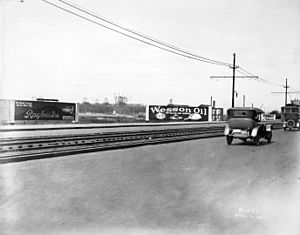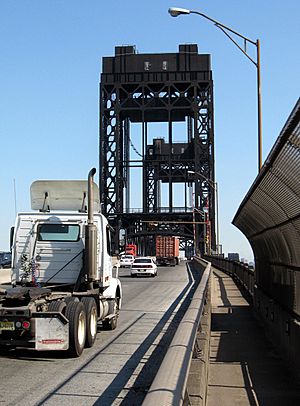Newark Plank Road facts for kids
The Newark Plank Road was a really important old road that connected Jersey City (which was called Paulus Hook back then) to the city of Newark. It stretched across the New Jersey Meadows, a large marshy area. As its name suggests, a plank road was built using wooden planks laid side-by-side. Imagine a road made of giant wooden boards! Other similar roads in the area were named after their destinations, like the Bergen Point Plank Road. Today, the name "Newark Plank Road" isn't used anymore because its path has become part of other modern streets and highways.
Contents
Building the First Road
Back in 1765, the government of the Province of New Jersey decided to build a new road. They wanted a path from Newark to a public road in Bergen, which led to Paulus Hook (today's Jersey City). This new road would make the trip between Paulus Hook and Newark about eight miles long. The plan was to make it a smooth, level road by building special raised paths called "causeways."
This road was super important because it would make it much easier for people and goods to travel from a large area to the markets in New York City. Everyone hoped that both the city and the countryside would help pay for this important project.
A special company was given permission to build this road and bridges over the Hackensack River and Passaic River. At first, people used ferries to cross these rivers. But by 1795, the bridges were finished, making travel much faster.
The Plank Road Era
On February 24, 1849, the road officially became known as the Newark Plank Road. It was improved with wooden planks to make the journey smoother. Later, around 1869, the Central Railroad of New Jersey built train tracks that followed a similar path. These tracks used special bridges called the PD Draw and HD Draw. Today, part of this old train route is used by the Hudson-Bergen Light Rail, a modern train system.
The Public Service Railway also had a trolley line, #1, that ran along much of the old road. When trolleys were replaced by buses, the #1 bus route continued to follow this historic path. Today, New Jersey Transit still operates the #1 bus route along this route.
Journey Through Jersey City
The Newark Plank Road started in Jersey City near the Hudson River on Grand Street. From there, a ferry would take travelers across to New York City. The road then followed Grand Street (County Route 622) and Communipaw Avenue (County Route 612). It then crossed the Hackensack River using what is now U.S. Route 1/9 Truck. After 1913, this bridge and its approach became part of the Lincoln Highway. This was one of the very first roads that went all the way across the United States!
Crossing Kearny Point
After crossing the Hackensack River on the Lincoln Highway Hackensack River Bridge, the road went through Kearny Point. This is the southern tip of a piece of land called New Barbadoes Neck, where the Hackensack and Passaic River meet. The road ran next to the Morris Canal, an old waterway. It then crossed the Passaic River on the Lincoln Highway Passaic River Bridge. This part of the road was also a section of the famous transcontinental Lincoln Highway and is still known by that name today.
Arriving in Newark
Ferry Street in the Ironbound section of Newark was once part of the plank road. It got its name from the ferry that used to travel between Newark and places to the east. In 1849, "The Newark Plank Road Company" was hired to improve the road with planks, making travel smoother. At that time, Ferry Street was even renamed "Plank Road."
However, the company didn't finish the work within the 50 years they were given. This led to a legal disagreement. As a result, the part of "Plank Road" in Hudson County was changed to the Lincoln Highway. The section in Essex County was changed back to "Ferry Street."




